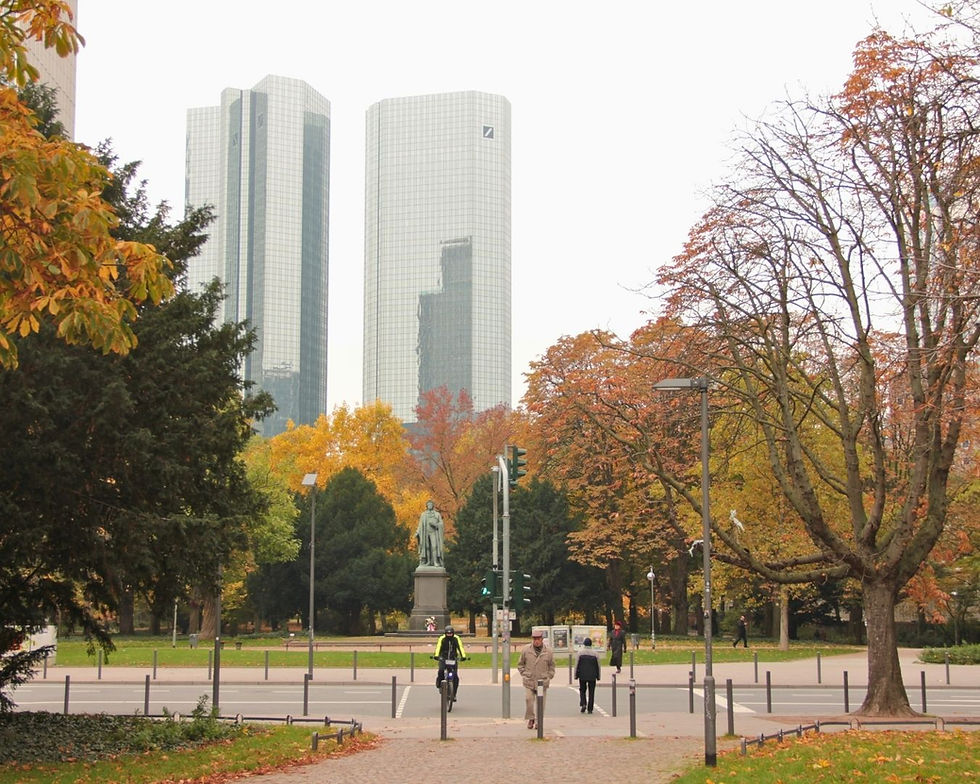Exploring Soft and Hard Edges in Urban Landscapes (Weekly Challenge #182)
- Natalia C.

- Sep 26
- 3 min read
This week, we’re heading to Frankfurt, Germany, which I visited almost six years ago during a spontaneous trip inspired by a Van Gogh exhibition. I remember that short trip vividly: the sharp chill of autumn, golden trees glowing in the city parks, and the grey-blue skyline looming above. Even the grumpy, overcast skies seemed to match the mood of the city, creating an atmosphere perfect for sketching and soaking in the contrast of nature and urban structure.
The scenes I captured during that visit still feel striking: towering buildings with their sharp edges, layered with soft, fading foliage or misty air. It felt like a collision of clarity and blur, structure and softness. That's the balance we're going to explore this week!
Focus Point: Soft & Hard Edges
Edges in painting aren't just technical, they're emotional and directional. The contrast between soft and hard edges can create movement, draw attention, and communicate depth and atmosphere.
Hard edges are created when two contrasting shapes meet with little or no blending. These edges tend to pop, guiding the viewer's attention. Think of the sharp corners of a skyscraper or the crisp silhouette of a lamppost against the sky.
Soft edges, on the other hand, are created through blending or subtle transitions. They appear where the subject dissolves into light, shadow, fog, or background. They add depth and softness, and are often used to push areas back or convey mood.
In the city, these edge contrasts are everywhere. From hard-edged buildings against soft, leafy branches, to fog creeping over rooftops, to reflections in windows that blur shapes into abstraction —they're all invitations to make choices as artists.
This week’s challenge is to play with those choices. Where will you sharpen an edge and where will you soften one to let it drift into atmosphere?
To dig deeper, check out my blog post: Beyond the Outline: How Edges in Landscape Art Shape Mood & Focus
Analyzing This Week’s Reference Photos
Now let us go to the photo references and what thez can offer.
Photo 1: Tower and Autumn Trees
A tall skyscraper rises behind a canopy of yellow leaves. The building’s hard architecture contrasts with
the soft, diffuse foliage in front.

Challenge as a photo: Capture that tension between the crisp geometry and the leafy blur.
Focus Questions:
Which edges will you sharpen — building corners or windows?
How soft can the tree edges become before they fade out?
Where does the fog or haze demand lost edges?
Painting Tips:
Use sharper edges on the building to make it a focal point.
Gradually soften tree edges as they recede.
Use mid-value transitions between hard and soft zones to bridge them.
Photo 2: Glass Facade & Reflections
Reflections of trees and sky shimmer across a building's glass surface, distorting and softening the edges.

Challenge as a photo: Use edge quality to differentiate between reflected and solid forms.
Focus Questions:
Which reflections deserve crispness?
Can softening reflections help deepen the composition?
How much blending is too much?
Painting Tips:
Use horizontal brushstrokes to mimic glass texture.
Soften edges within reflections to add visual rhythm.
Keep structural lines of the building subtly crisp for contrast.
Photo 3: Historic Meets Modern
A frame of tree branches reveals both old architecture and modern buildings behind.

Challenge as a photo: Play with how foreground softness affects background sharpness.
Focus Questions:
Do the tree branches frame or obstruct your focal point?
Will you paint both buildings with the same edge sharpness?
Which element do you want to bring forward?
Painting Tips:
Let some tree branches have broken or soft edges.
Emphasize one architectural structure by giving it crisper lines.
Allow more muted tones and edges in the background.
Photo 4: Foggy Skyline
Clouds and fog obscure the upper edges of high-rise buildings, dissolving form into sky.

Challenge as a photo: Work with lost and found edges to convey mood.
Focus Questions:
Where does the building disappear into the sky?
Which parts should remain solid to ground the viewer?
Can you use color to support the edge softness?
Painting Tips:
Use upward gradients to transition from solid to mist.
Maintain stronger contrast at the base of buildings.
Allow sky and clouds to gently invade structural edges.
Each photo gives you an opportunity to experiment with edge control in a unique context. Whether you want to go highly realistic or painterly and loose, edge handling will be your most powerful tool.
Take your pick, sketch your draft, and don’t forget to post your work by the deadline using the hashtag #landscapeartclub182 on Instagram to get a chance to get featured.



Comments